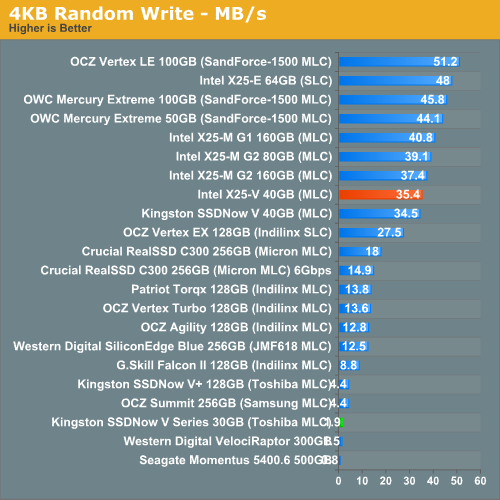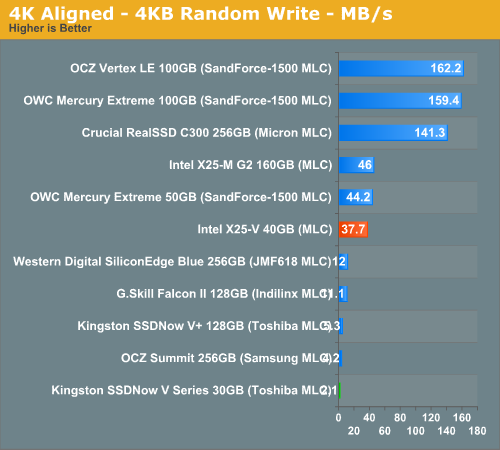Intel's X25-V & Kingston's 30GB SSDNow V Series: Battle of the $125 SSDs
by Anand Lal Shimpi on March 19, 2010 12:00 AM EST- Posted in
- Storage
Random Read/Write Speed
This test reads/writes 4KB in a completely random pattern over an 8GB space of the drive to simulate the sort of random access that you'd see on an OS drive (even this is more stressful than a normal desktop user would see). I perform three concurrent IOs and run the test for 3 minutes. The results reported are in average MB/s over the entire time.
I've had to run this test two different ways thanks to the way the newer controllers handle write alignment. Without a manually aligned partition, Windows XP executes writes on sector aligned boundaries while most modern OSes write with 4K alignment. Some controllers take this into account when mapping LBAs to page addresses, which generates additional overhead but makes for relatively similar performance regardless of OS/partition alignment. Other controllers skip the management overhead and just perform worse under Windows XP without partition alignment as file system writes are not automatically aligned with the SSD's internal pages.
First up is my traditional 4KB random write test, each write here is aligned to 512-byte sectors, similar to how Windows XP might write data to a drive:

Intel's drives have traditionally done very well in random write tests and the X25-V is no different. Here it performs like a much more expensive X25-M G2. The SSDNow V Series Boot Drive however is at the bottom of the charts in single digits here.
Running 4K aligned writes (similar to Windows 7 or OS X 10.5/6) doesn't improve the situation much in either case:

Random read performance is equally strong for Intel:

And equally weak for Kingston.










78 Comments
View All Comments
Anand Lal Shimpi - Friday, March 19, 2010 - link
No, unfortunately it looks like the bracket keeps the drive centered, which positions the SATA connectors too far to the middle to work properly in 3.5" carriers like what Apple uses for the Mac Pro.Take care,
Anand
Drakino - Friday, March 19, 2010 - link
Thanks for the response. If you can pass some feedback to the manufacturers, can you let them know this is one of the big reasons I haven't jumped on a SSD yet? A SATA compliant 3.5 inch solution would be appreciated by those of us using cableless drive setups. I know HP shipped a few VoodooPC gaming rigs with similar drive bays.I'm still really tempted to pick one of these up, but not sure how I can get it in my system without just dangling the drive on the connector.
Nomgle - Wednesday, March 24, 2010 - link
See below - Icy Dock make two adaptors that'll fit your Mac Pro just fine :)vol7ron - Friday, March 19, 2010 - link
Anand,Though I'm still operating almost all my machines on XP, I thought you said you were going to start doing all your benchmarks in Win7.
I appreciate doing both in this example, but that's got to be a lot of time spent doing it on multiple machines.
vol7ron
PS
This article really interests me when thinking about building an HTPC. I know I'll need a lot of storage space - I hope to have 4TB worth - but having a quick, speedy, small drive would be a loading dream. Thanks for the review.
Itomerou - Friday, March 19, 2010 - link
I really enjoyed the article and am always impressed with the level of detail that is done when testing and comparing components. However, the only problem with this article is that when comparing queue depth and light/heavy workload averaging the results provides no value in so far as the distribution of IOPS is not normally distributed. Additionally, the fact that these drives are completely different in their drivers and priority addressing of queue requests to say that one drive is able to server requests faster depends on the fact that measurement of requests served fits the drives exact distribution of requests served. This is apparent with the charts of how each drive performs for sequential and random access. Finally, in order to make substantial claims confidence intervals must also be constructed otherwise how accurate are the results?On the otherhand I am still intrigued with the findings.
Zelog - Friday, March 19, 2010 - link
Look at the size of the kingston, it's tiny! Now you don't even need dedicated 2.5" space for the drive, making the htpc/laptop/net book even smaller. It is definitely worth its price in the right settings.GeorgeH - Friday, March 19, 2010 - link
That was my first thought, but with a slightly different angle. If Kingston made a custom form factor you could extend laptops with dual storage below ~15". In something like the M11x you could have one of these as a fast boot drive while using a big and slow HDD with aggressive power management to get more storage, faster storage, and longer battery life.(Yes, I'm aware of mini-PCIe (and other custom connection) SSDs for netbooks and other SFF devices, but the performance there is terrible.)
Shadowmaster625 - Friday, March 19, 2010 - link
Entry level is not $125. $125 is not "cheap" or "inexpensive".davepermen - Friday, March 19, 2010 - link
it's a cheap and inexpensive SSD, and definitely the most entry level ssd existing.and yeah, if you buy an entry level desktop (not an atom), you easily pay several 100$. investing 100 more to make it perform 'really fast', is the most cheap and inexpensive way to make it perform much better.
how would YOU invest that amount of money to boost up your pc? (laptops are a different story because there storage matters actually, in a pc, just let the old hdd be plugged in too)
casteve - Friday, March 19, 2010 - link
The OCZ 30GB Agility @ $119 wins the entry level contest over these two. $99 after MIR at newegg.